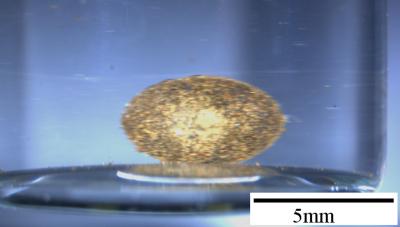Home > Press > Building giant 'nanoassemblies' that sense their environment
 |
| An optical photograph reveals self-assembly of hybrid nanowires resulting in this golden droplet. Such structures could help develop nanomachines for the medical community, scientists report.
Credit: Courtesy of Pulickel M. Ajayan |
Abstract:
Researchers in Texas are reporting the design, construction, and assembly of nano-size building blocks into the first giant structures that can sense and respond to changes in environmental conditions. The study, scheduled for the July 9 issue of ACS's Nano Letters, a monthly journal, terms those structures "giant" because they are about the size of a grain of rice — millions of times larger than anything in the submicroscopic realm of the nanoworld.
Building giant 'nanoassemblies' that sense their environment
Washington, DC | Posted on June 24th, 2008In the new study, Pulickel M. Ajayan and colleagues point out that such structures are a step toward the development of futuristic nanomachines with practical applications in delivering medicines to patients, labs-on-a-chip, and other products. Until now, scientists have had difficulty in using nanomaterials to build more complex, multifunctional objects needed for those applications.
The researchers describe development of a hybrid nanowire consisting of segments with water-repelling carbon nanotubes on one end and water-attracting metal nanowires on the other end. In laboratory tests, they showed that the nanowires could assemble themselves into larger, more complex structures when placed in water. The structures also sensed and responded to their environment by making movements when exposed to chemicals, magnets, and light. The findings "could lead to the creation of smart materials that are a cornerstone for the development of nanotechnology-based applications," the study notes.
####
For more information, please click here
Contacts:
Michael Woods
202-872-4400
Pulickel M. Ajayan, Ph.D.
Rice University
Houston, Texas 77251-1892
Phone: 713-348-5904
Fax: 713-348-5423
Copyright © American Chemical Society (ACS)
If you have a comment, please Contact us.Issuers of news releases, not 7th Wave, Inc. or Nanotechnology Now, are solely responsible for the accuracy of the content.
| Related Links |
| Related News Press |
News and information
![]() Simulating magnetization in a Heisenberg quantum spin chain April 5th, 2024
Simulating magnetization in a Heisenberg quantum spin chain April 5th, 2024
![]() NRL charters Navy’s quantum inertial navigation path to reduce drift April 5th, 2024
NRL charters Navy’s quantum inertial navigation path to reduce drift April 5th, 2024
![]() Discovery points path to flash-like memory for storing qubits: Rice find could hasten development of nonvolatile quantum memory April 5th, 2024
Discovery points path to flash-like memory for storing qubits: Rice find could hasten development of nonvolatile quantum memory April 5th, 2024
Molecular Machines
![]() First electric nanomotor made from DNA material: Synthetic rotary motors at the nanoscale perform mechanical work July 22nd, 2022
First electric nanomotor made from DNA material: Synthetic rotary motors at the nanoscale perform mechanical work July 22nd, 2022
![]() Nanotech scientists create world's smallest origami bird March 17th, 2021
Nanotech scientists create world's smallest origami bird March 17th, 2021
![]() Giant nanomachine aids the immune system: Theoretical chemistry August 28th, 2020
Giant nanomachine aids the immune system: Theoretical chemistry August 28th, 2020
Molecular Nanotechnology
![]() Scientists push the boundaries of manipulating light at the submicroscopic level March 3rd, 2023
Scientists push the boundaries of manipulating light at the submicroscopic level March 3rd, 2023
![]() First electric nanomotor made from DNA material: Synthetic rotary motors at the nanoscale perform mechanical work July 22nd, 2022
First electric nanomotor made from DNA material: Synthetic rotary motors at the nanoscale perform mechanical work July 22nd, 2022
![]() Nanotech scientists create world's smallest origami bird March 17th, 2021
Nanotech scientists create world's smallest origami bird March 17th, 2021
Discoveries
![]() Chemical reactions can scramble quantum information as well as black holes April 5th, 2024
Chemical reactions can scramble quantum information as well as black holes April 5th, 2024
![]() New micromaterial releases nanoparticles that selectively destroy cancer cells April 5th, 2024
New micromaterial releases nanoparticles that selectively destroy cancer cells April 5th, 2024
![]() Utilizing palladium for addressing contact issues of buried oxide thin film transistors April 5th, 2024
Utilizing palladium for addressing contact issues of buried oxide thin film transistors April 5th, 2024
Announcements
![]() NRL charters Navy’s quantum inertial navigation path to reduce drift April 5th, 2024
NRL charters Navy’s quantum inertial navigation path to reduce drift April 5th, 2024
![]() Discovery points path to flash-like memory for storing qubits: Rice find could hasten development of nonvolatile quantum memory April 5th, 2024
Discovery points path to flash-like memory for storing qubits: Rice find could hasten development of nonvolatile quantum memory April 5th, 2024
|
|
||
|
|
||
| The latest news from around the world, FREE | ||
|
|
||
|
|
||
| Premium Products | ||
|
|
||
|
Only the news you want to read!
Learn More |
||
|
|
||
|
Full-service, expert consulting
Learn More |
||
|
|
||








